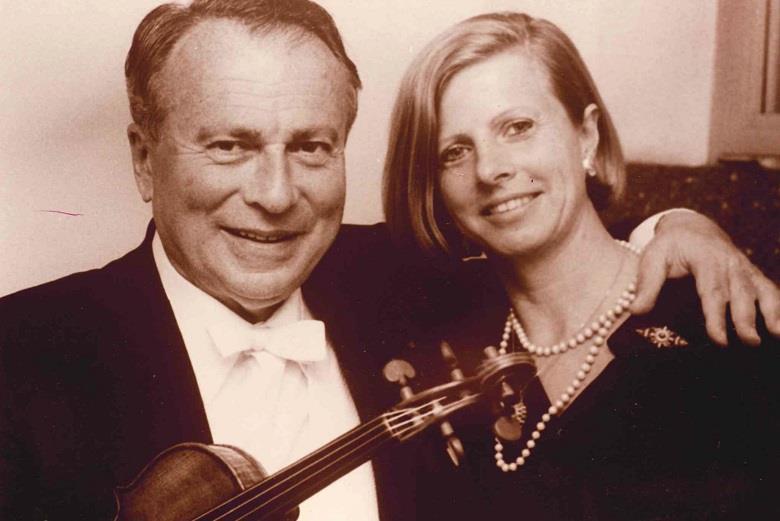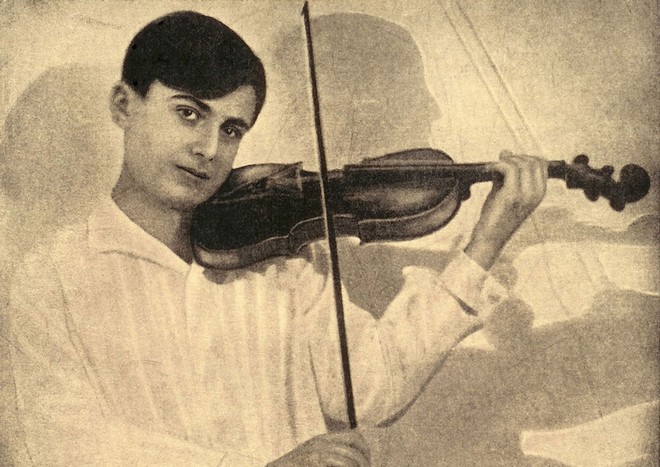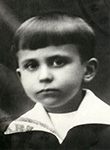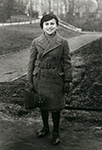

1918-1988
One of the music’s great aristocrats, violinist Henryk Szeryng was a perfectionist in all things. A man of phenomenal intellect, he combined exemplary musical taste with a super-refined technique and ravishing purity of intonation.
1918
22 September
Henryk Boleslaw Szeryng is born in Warsaw, Poland.
1925

1925 – 1927
Violin studies with Maurice Frenkel, student of Leopold Auer in St.Peterburg.
Szeryng about Frenkel:
One of his most valuable instructions was: “When playing the violin, your left elbow has to be exactly on the level of your heart”.
1927
Audition for Bronislaw Huberman. “The boy has great talent with hands like Jascha Heifetz”, he says afterwards and advises further studies in Berlin and Paris.
Szeryng about Huberman:
“When he was discussing music, it was more than a lesson; it was opening new horizons that were not actually visible. Bronislaw Huberman was responsible for my becoming a violinist.”
1928
1928 – 1930
Studying with Willi Hess in Berlin.
Szeryng about his time in Berlin:
“My first year was particularly difficult, I was only 10 and my knowledge of German was rather inadequate.”

1930
1930 – 1933
Studying with Carl Flesch the entire great violin repertoire at the „Staatliche Hochschule für Musik“ in Berlin and in Baden-Baden (master classes 1932 and 1933).
1933
6 January
Szeryng makes his debut as a concert artist.
Performance in Warsaw – Johannes Brahms: violin concerto in D, op.77 – Warsaw Philharmonic, conductor is Georges Georgescu.
Szeryng about Brahms: “If there was anybody who loved beauty, it was Brahms. I feel very close to Brahms – and let’s hope that Brahms feels close to me!”
Summer
Audition in Paris for the Polish Prime Minister and composer Ignaz Paderewski.
Szeryng about Paderewski:“He was very kind, had beautiful manners, radiating so much goodness, so much dignity. He was impressive, not only because of who he was, but also because of the way, he looked: tall with beautiful hair, covering part of his shoulders. He was such a regal type.”
17 December
First performance in Paris – Salle Pleyel – Johannes Brahms: violin concerto in D, op.77 – Paris Symphony Orchestra, conductor is Pierre Monteux.
1934
13 April
Second performance in Warsaw: Ludwig van Beethoven: violin concerto in D, op.61 – Warsaw Philharmonic Orchestra, conductor is Bruno Walter.
31 October
First performance in Vienna in the presence of Arturo Toscanini – Otto Schulhof, piano.
1935
1935 – 1936
Studying in Paris almost the entire French violin literature under the guidance of Jacques Thibaud.
1936
April
Performance in Lausanne – Swisss premiere of Karol Szymanowski’s violin concerto #2 – Orchestre de la Radio de la Suisse Romande, conductor is Hans Haug.
Simultaneously Pavel Kochansky, the violinist to whom the concerto had been dedicated, premieres it in Warsaw and later in New York. Zino Francescatti will premiere it in Paris with the Orchestre des Concerts Colonne under Paul Paray.
18 November
Enters the class of Gabriel Bouillon at the Paris National Conservatory. Director of the Conservatory is the composer and conductor Henri Rabaud (1873-1949).
1937
16 July
Graduation from the Conservatory with the First Prize, “Premier Nommé des Hommes et Femmes” and the Sarasate Prize.
Szeryng gets his first fine instrument: the Andrea Guarnerius 1683 “Sancta Theresiae”. The violin had belonged to the Italian composer Giuseppe Tartini (1692-1770) at the time when he composed the “Devil’s thrill”. Later, Nicolò Paganini’s only student, Camille Sivori (1815-1894), owned the violin.
Studying with Nadia Boulanger, renowned composition teacher in Paris.
1939
Autumn
Encounter with the Prime Minister of the Polish Government in Exile, General Wladyslaw Sikorski at his headquarters in Paris. Szeryng becomes a volunteer in the Polish Army abroad. Beginning of 1940 he gives numerous benefit concerts for the Polish Army in Paris and France.
1940
November
Emigrates to Brazil. For a couple of years Rio de Janeiro will be his basis from where he will develop a regular concert activity in South America, combined with diplomatic missions for the Polish Government in Exile.
1942
December
First visit to Mexico City with General Sikorski, who is in search of a home for about 4.000 Polish refugees displaced by the war. The Mexican President Manuel Ávila Camacho offers them asylum and assures Henryk Szeryng that he will always be welcome to live in Mexico.
1940
November
Emigrates to Brazil. For a couple of years Rio de Janeiro will be his basis from where he will develop a regular concert activity in South America, combined with diplomatic missions for the Polish Government in Exile.
1942
December
First visit to Mexico City with General Sikorski, who is in search of a home for about 4.000 Polish refugees displaced by the war. The Mexican President Manuel Ávila Camacho offers them asylum and assures Henryk Szeryng that he will always be welcome to live in Mexico.
1950
Summer
Encounters Arthur Rubinstein in Mexico City.
That same year they prepare future recordings. (In 1958 they record Beethoven’s „Spring“ and Kreutzer“ Sonata, in 1960 the three Brahms Sonatas, later in 1972 with Pierre Fournier the three Brahms Trios and in 1974 the Schumann as well as the Schubert Trios op.99 und 100).
1956
The Mexican Government names Szeryng Mexican Roving Ambassador for Culture and Goodwill. He is the first artist to travel henceforth on a diplomatic passport.
1959 1961
Performance in Mexico City – world premiere of the definite version of the violin concerto by Carlos Chavez – Orquesta Sinfónica Nacional de México, conductor is the composer.
Performance in Paris – world premiere of the violin concerto#2 by Jean Martinon (dedicated to Henryk Szeryng) –Théâtre des Champs Elysées – Orchestre Philharmonique de la Radio Télévision Française, conductor is the composer.
1963
February
Performance in Boston – World premiere of the violin concerto #2 by Benjamin Lees (dedicated to Henryk Szeryng) – Boston Symphony.
7 October
1970
Szeryng discovers the long-lost third violin concerto by Nicolò Paganini at the home of his great-granddaughters. He composes the cadenzas and records the concerto under the Philips label in January 1971 with the London Symphony Orchestra under Sir Alexander Gibson.
1972
24 December
Following his concert in Jerusalem on the 25th anniversary of the State of Israel in the presence of Prime Minister Golda Meir and Teddy Kollek, Mayor of Jerusalem, Szeryng donates his violin Antonio Stradivarius 1734 “Hercules”, Ex-Eugene Ysaye to the City of Jerusalem.
Since then, the violin bears the name of “Kinor David Stradivarius” and is played by the concertmasters of the Israel Philharmonic Orchestra.
1974
12 January
Mexico City – Residence of the Mexican president Luís Echeverría Alvárez. Henryk donates his violin Andrea Guarnerius 1683 “Sancta Theresiae” (see 16 July 1937) to the State of Mexico. Since, it is played by the concertmasters of the Orquesta Sinfónica Nacional de México.
1975
7 May
In Tel Aviv Szeryng establishes “The Henryk Szeryng Fund”, a loan fund for the acquisition of instruments by members of the Israel Philharmonic Orchestra. He will contribute to it until April 1987.
1983
Szeryng celebrates his 50 years on stage.
1985
28 July
Principality of Monaco – Szeryng donates his violin Jean-Baptiste Vuillaume, 1861, a copy of the Stradivarius’ “Messiah” to Prince Rainier III. Since it is played by one of the concertmasters of the Monte Carlo Philharmonic Orchestra.
1987
19 November
Performance in Atlanta, Georgia – USA premiere of Reynaldo Hahn’s violin concerto in D – Atlanta Symphony, conductor is Louis Lane.
The French violinist Gabriel Bouillon gave the first and only performance to date of this work on 26 February 1928 in Paris with the Orchestre des Concerts Colonne under the baton of the composer. After almost 60 years Szeryng brings the concerto back on stage.
1988
1st March
Performance in Kassel while on a German tour – Johannes Brahms: violin concerto in D, op.77 – Orchester des Saarländischen Rundfunks, conductor is Myung Whun Chung.
In the night following the concert, Henryk Szeryng falls into a coma. He passes away in the early morning of 3 March 1988.
Henryk Szeryng ends his career as he started it 55 years ago: with the Brahms violin concerto. Is it coincidence, destiny or the fulfilment of a wish? Almost 10 years before, on 23 July 1978, he gave an interview to the Mexican newspaper “Excelsior”. One of the journalist’s last questions was “What would you do, if you had only one more hour to live?” and Szeryng answered, “I would play the Brahms concerto.”
Henryk Szeryng plays Brahms Violin Concerto (audio) Rundfunk-Sinfonieorchester Saarbrücken Myung-Whun Chung, conductor Jahrhunderthalle Frankfurt-Höchst February 29, 1988 https://www.youtube.com/watch?v=eUY9h_E_89o
https://www.youtube.com/watch?v=eUY9h_E_89oc
« I consider music as the noblest language,
bringing comfort, joy, inspiration and peace to mankind.
I think that it is vital that peace be preserved,
and if music can help – then let’s have music!. ».
Henryk Szeryng
http://www.henrykszeryng.net/chronology?lang=en
Henryk Szeryng (* 22. September 1918 in Warschau; † 3. März 1988 in Kassel) war ein polnisch-mexikanischer Geiger, Violinpädagoge, Herausgeber, Komponist und Diplomat, der seit 1946 in Mexiko lebte und seit dem 21. Oktober 1948 die mexikanische Staatsbürgerschaft hatte.
Seine Mutter erteilte ihm ersten Klavierunterricht, doch das Kind bevorzugte bald die Geige. Bronisław Huberman hörte ihn und empfahl, ihn zur Ausbildung zu Carl Flesch nach Berlin zu schicken (1928–32). Henryk Szeryng debütierte im Jahre 1933. 1935 spielte der 17-jährige Geiger in Warschau unter der Leitung von Bruno Walter das Violinkonzert von Ludwig van Beethoven. Anschließend setzte er bis 1939 sein Studium bei Nadia Boulanger in Paris fort.
Nach Beginn des Zweiten Weltkriegs meldete er sich als Freiwilliger bei der polnischen Armee auf französischem Boden und wurde Verbindungsoffizier. Aufgrund seiner Sprachkenntnisse (Szeryng sprach acht Sprachen) arbeitete er auch als Dolmetscher für die polnische Exilregierung. Häufig konzertierte er vor alliierten Soldaten und gab Wohltätigkeitskonzerte.
Während eines Aufenthaltes in Mexiko-Stadt bekam er das Angebot, dort die Streicherabteilung an der Universität Mexiko zu übernehmen. Er tat dies und wurde 1948 mexikanischer Staatsbürger. Erst 1954 nahm er seine Konzertkarriere auf, die er bis zu seinem Tode fortführte. Im Rahmen einer Konzerttournee mit dem Rundfunk-Sinfonieorchester Saarbrücken spielte Henryk Szeryng am 1. März 1988 in Kassel das Violinkonzert von Johannes Brahms. In der Nacht vom 1. auf den 2. März fiel er nach einer Gehirnblutung in ein Koma. Er erwachte nicht mehr und starb in den Morgenstunden des 3. März 1988.
Der Geiger war ein Interpret mit einem umfangreichen Repertoire und erlangte weltweite Anerkennung. Er nahm eine große Anzahl von Platten auf mit den Violinkonzerten von Bach, Mozart, Beethoven, Brahms, Schumann, Tschaikowski, Sibelius, Mendelssohn und Paganini, sämtlichen Violinsonaten von Beethoven und Mozart mit Ingrid Haebler, ausgewählten Violinsonaten von Beethoven und Mozart mit Arthur Rubinstein und zwei Aufnahmen der gesamten Sonaten und Partiten für Violine solo von Bach. Für seine Zusammenarbeit mit Pierre Fournier und Arthur Rubinstein erhielt er 1975 und 1976 je einen Grammy. Für seine Aufnahme des Brahms-Konzertes im Jahre 1959 mit Pierre Monteux erhielt er den Grand Prix du Disque. Seine Einspielungen der Bachschen Solosonaten und Partiten werden bis heute als maßstabsetzend angesehen. So hat in dem Video The Art Of Violin die bedeutende junge Geigerin Hilary Hahn dargestellt, dass Szeryngs Bach-Einspielungen für ihre eigene Bach-Interpretation richtungsweisend sind. https://de.wikipedia.org/wiki/Henryk_Szeryng
Alex Saldarriaga3 jaar geleden
Szeryng was more than a great violinist and a supreme artist. He was great human being. A kind and generous man, he gave much of himself to others – especially to those in need. I had the honor and privilege of meeting him and his lovely wife back in the 1980s. Even though I’m a nobody, he treated me with great kindness, gave me his full attention when I was with him, and even called me “Alejandro Magno”! He autographed his edition of the Bach Solo Sonatas and Partitas for Violin, which I will always treasure and cherish. I miss him and his great artistry. God rest his soul. Thank you for uploading this wonderful video.
Rundfunk-Sinfonieorchester Saarbrücken Myung-Whun Chung, conductor Jahrhunderthalle Frankfurt-Höchst February 29, 1988
